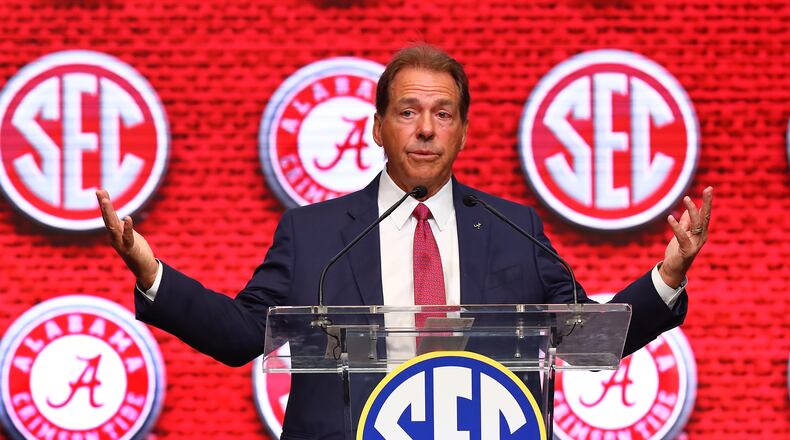At this event last year in Hoover, Ala., Alabama’s Nick Saban raised eyebrows when he casually mentioned that at least one of his players had inked an NIL deal approaching $1 million. The Crimson Tide’s legendary coach offered some numbers again Tuesday at SEC Media Days.
Unsolicited, Saban mentioned that Alabama players have garnered name, image and likeness deals totaling more than $3 million. He proudly proclaimed that as “better than anybody in the country.”
Of course, none of that is independently verifiable. NIL revenue directed to collegiate athletes, whether it be through individual transactions or fan-funded “collectives,” is protected from public review by federal privacy laws. Whether it should be is a matter being legally challenged in the courts.
But NIL clearly has become a part of the recruiting process, even though it never was intended to be. Hence, Saban was willing to share his players’ private business at a public forum attended by hundreds of sports journalists.
“I’m all for the players being able to do as well as they can and use their name, image and likeness to create value for themselves,” Saban said from the podium in the main hall of the College Football Hall of Fame on Tuesday. “We have a great brand at Alabama, so players are certainly going to be enhanced because of the value that our brand can help them create.”
Saban didn’t offer that public endorsement until he was asked about it in the question-and-answer portion of his appearance that started Tuesday’s round of interviews.
Just an interesting as Saban’s remarks was the very number he shared. It was his and others’ accusations that Texas A&M had raised $3 million through its primary school collective to fund their 2022 recruiting class. That class ended up with a No. 1 national ranking, according to the 247Sports Composite. That spot most often has been occupied by the Crimson Tide – if not Georgia – in recent years.
Saban’s public comments earlier this summer on how the Aggies accomplished their recruiting feat after averaging a No. 9 ranking in the previous five classes set off a war of words with Texas A&M coach Jimbo Fisher. Actually, it was Fisher doing most of the talking, vehemently denying that NIL had anything to do with gathering the assemblage of new talent.
It’s probably no coincidence that Saban and Fisher’s appearances at SEC Media Days this year are separated by two days.
Regardless, NIL is here to stay, thanks to the Supreme Court’s Alston decision in the summer of 2021. And while NIL is definitely making an impact in recruiting, it also is making its intended impact in the lives of the athletes it was meant to serve. That goes double for the players who play for high-profile, major programs such as Alabama and Georgia, which played in both the SEC and College Football Playoff championship games last season.
Asked how, if at all, NIL has changed his life, Crimson Tide linebacker Will Anderson said, “It has, a lot.”
“It’s been tremendous for me,” said Anderson, an All-American and Nagurski Award winner from Dutchtown High School. “It’s been able to help me and my family. Right now, I’m able to put money aside for myself, of course. But I’m really doing NIL to help my family out. I really don’t want my family to be stressed or worried about things or how they’re going to get to our games or anything like that.”
Alabama quarterback Bryce Young, thought to be the player Saban was referencing last year, is leading the way in pulling down the big bucks this year, too. According to the recruiting website On3.com, which attempts to keep an accounting of NIL revenue streams for college football players, Young’s estimated valuation of $3.1 million is highest in the country, and No. 3 on the NIL list of all athletes. He is known to have deals with Cashapp/Bitcoin, Subway, Logan’s Roadhouse and BMW of Tuscaloosa, among others.
But, again, nobody knows for sure.
Georgia quarterback Stetson Bennett is considered the leading breadwinner for the Bulldogs. On3.com lists his algorithmic valuation at $713,000, which ranks 19th among college football players. Arch Manning, a rising high school senior quarterback that Georgia was recruiting, is No. 2 on the overall list at $3.2 million. He committed to Texas this summer.
Attracting big money for non-professionals was not the original intent of NIL. At its core, it was to prevent heavy-handed actions such as the NCAA took in the past against former Georgia players A.J. Green and Todd Gurley. Each was suspended four games in their final college seasons for selling a bowl-game jacket and autographed-memorabilia, respectively.
For the majority of college players, however NIL hasn’t meant life-changing money. It simply has improved their quality of life beyond their academic and athletic perks.
“I like to take the other DBs out to eat sometimes,” Alabama senior safety Jordan Battle said. “I’m trying to focus on building better relationships with other position groups, too.”
Of course, NIL is not just designed to enhance the powerhouse programs and their athletes. Don’t count out the impact it might make at institutions like Vanderbilt. Not only does the private school have one of the largest private endowments in the country, it is located in a town that has more than twice the population (about 693,000) as the next-most populous SEC city.
“We have a great partnership with the city of Nashville,” Vanderbilt coach Clark Lea said. “Obviously, we’re right in the hub of a lot of activity, specifically with where our campus sits. We’ve definitely seen benefit in that. I think as we continue to strengthen our team and strengthen our brand as Vanderbilt football in the city, we’ll continue to reap the rewards of being in such a fruitful ground.”
All the SEC programs are doing their best to take advantage of the new NIL laws. Alabama, as Saban so proudly noted, apparently is doing it as well as anybody.
But he continued to express concern about the long-term of effects of an unregulated income streams directed at college athletes.
“There’s got to be some uniformity and protocol of how name, image and likeness is implemented,” Saban said. “… How does this impact competitive balance in college athletics? And is there transparency to maintain fairness across the board in terms of college athletics?”
Transparency would be a good place to start but, alas, there is none at the moment.
Old-fashioned economics likely will slow the NIL flow eventually. Wealthy alumni didn’t get that way by making poor financial decisions. A few risky investments into 5-star prospects who don’t live up to their billing should provide more caution in the future.
In the meantime, the competitive spirit that fuels collegiate athletics is fueling the NIL landscape. Alabama, for one, is leading the charge.
“We’re one of the haves,” Saban proclaimed. “Don’t think that what I’m saying is a concern that we have at Alabama because we’re one of the haves. But everybody in college football cannot do these things relative to how they raise money in a collective or whatever, how they distribute money to players. Those are the concerns that I have in terms of how do we place guidelines around this so that we can maintain a competitive balance?”
For now, competitive imbalance will have to do.
About the Author
Keep Reading
The Latest
Featured

